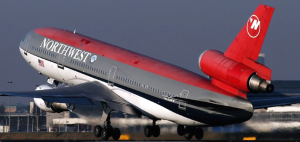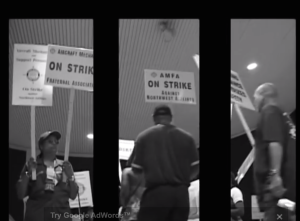AMFA’s Northwest Airlines Tragedy: In 1999 the AMFA finally achieved the big victory in longed for against the IAM in a bitter election dispute over mechanic and related employees at Northwest Airlines. On June 1, 1999 the National Mediation Board (NMB) certified AMFA as the mechanic and related representative, 54 percent to 45 percent.
AMFA had instantly become a major player in the airline industry. It would soon engage in negotiations with a major US carrier and represent over 10,000 mechanics in the industry. It was “show time” for AMFA; it now had to deliver on all its promises made over a 40 year history. AMFA promised Northwest mechanics industry-leading wages, retirement and scope language that would eliminate all farm-outs and the best lay-off protection in the industry.
AMFA claimed it could and would accomplish this because highly skilled mechanics belonging to an independent craft only association would not have to subsidize the wages and benefits of the unskilled. AMFA could no longer use the excuse that the reason the association never before could negotiate industry-leading contracts is because they represented mechanics and small carriers such as Ozark, Hughes Airwest or Atlantic Coast Airlines. AMFA had to deliver. AMFA had to prove that, indeed, it was industrial unions that suppressed the wages of highly skilled mechanics to boost the wages of the unskilled.
AMFA was on center stage and all industry aircraft mechanics were watching. After exhausting almost every provision of the Raliway Labor Act (RLA), and just before PEB 235 handed down its recommendations, AMFA and Northwest settled on was was hailed as the most lucrative contract negotiated in recent history. The deal included hefty pay raises, retirement increases and, what was characterized at the time, “iron clad” scope language.
Many observers in the union movement scratched their heads and questioned, how could a tiny association like AMFA get this type of agreement against a giant like Northwest?
The Devil Was in the Details:
AMFA gave away language that allowed Northwest to farm-out 38% of all Airframe, Engine and Component work. In addition, AMFA offered Northwest unlimited farm-out language as long as the association was compensated. The problem was neither side agreed what exactly “compensated” meant because of AMFA’s poorly defined scope provisions and AMFA never recouped any compensation.
Northwest Airlines wasted little time implementing their new, industry-leading farm-out language. The contract was signed on May 11, 2001, and before the ink was dry, on May 14, 2001, Northwest management implemented the largest farm-out of mechanic’s work in the airline’s history. In addition to the $390 million farm-out of engine overhaul work to Pratt and Whitney, Northwest scheduled the following outsourcing soon after:
–Dothan: Six DC9s: light and heavy checks
–San Antonio: Six DC9s: light and heavy checks
–Witchita: Boeing, Nine DC10s and 747s: light and heavy checks
–Singapore: Hong Kong Airways: 20 DC10s and 747s
–Seattle: BF Goodrich: All 727 checks
–Phoenix: All DC10 interior configurations.
AMFA’s “iron clad” scope and layoff protection lasted a total of seven days, but the furloughs continued unabated on a quarterly basis. The largest coming in October, 2002 when Northwest announced the closing of its Minneapolis maintenance facility. Then the industry began to falter and Northwest demanded concessions from every employee group. AMFA had always claimed it would never engage in concessionary negotiations and maintained the mantra, “full pay to the last day.” However, since AMFA just negotiated major concessions for the United mechanics (more on that on another page), it softened its stance at Northwest. But AMFA demanded Northwest take more from the unskilled and less from highly skilled AMFA members. Northwest refused.
“The Suicide Strike”:
AMFA thought this was a battle it could win. It was finally time for the association to prove that the mechanics’ power lie in their skill. AMFA reasoned that if all mechanics withheld their skill, Northwest would be crippled and AMFA would gain leverage at the bargaining table. Northwest, however, had other plans. The carrier was prepared for a fight and set aside over $100 million and trained 1,200 aircraft mechanics to replace
striking AMFA mechanics. Moreover, Northwest reduced the mechanic headcount from over 10,000 to approximately 3,800 due to AMFA’s poorly defined scope language. Northwest planned on operating with a skeleton maintenance structure.
AMFA was woefully unprepared to take on a fight of this magnitude: It had no strike fund, it did not coordinate any type of membership assistance program and publicly boasted that its highly skilled membership would bring Northwest to its knees. Northwest demanded not only wage concessions but they also wanted to halve the mechanic workforce. The carrier already had closed maintenance bases and farmed-out a majority of their maintenance program. Northwest was way more prepared for a fight than AMFA was, and AMFA’s poor scope language prepared the carrier even further.
AMFA was in complete isolation, true to its long standing philosophy of “going it alone.” AMFA proceeded to strike Northwest Airlines without taking a strike vote, putting Northwest’s last best offer to a vote or having a strike fund. Northwest’s final offer, albeit a tough pill to swallow, contained job protection for 2,700 mechanics, two weeks of severance pay for each year of service (max 26 weeks) and included company medical benefits for 26 weeks for those members subject to a reduction. AMFA members never got to vote of this offer, or two subsequent offers.
The resolution to the strike was a complete surrender by a beaten AMFA. The agreement placed every striking member on layoff status with a severance payment of one week per year (max 5 weeks). AMFA agreed to a “No Retribution, Retaliation or Harassment Due to Participation or Non-Participation in the Strike or Permanent Replacement Status.” In short, the scabs kept their jobs while the strikers lost theirs. AMFA Northwest mechanics were reduced to about 500 scabs, most of whom were laid off before the “suicide strike.”
After the merger with Delta, AMFA extinguished their certification with no fight at all.


